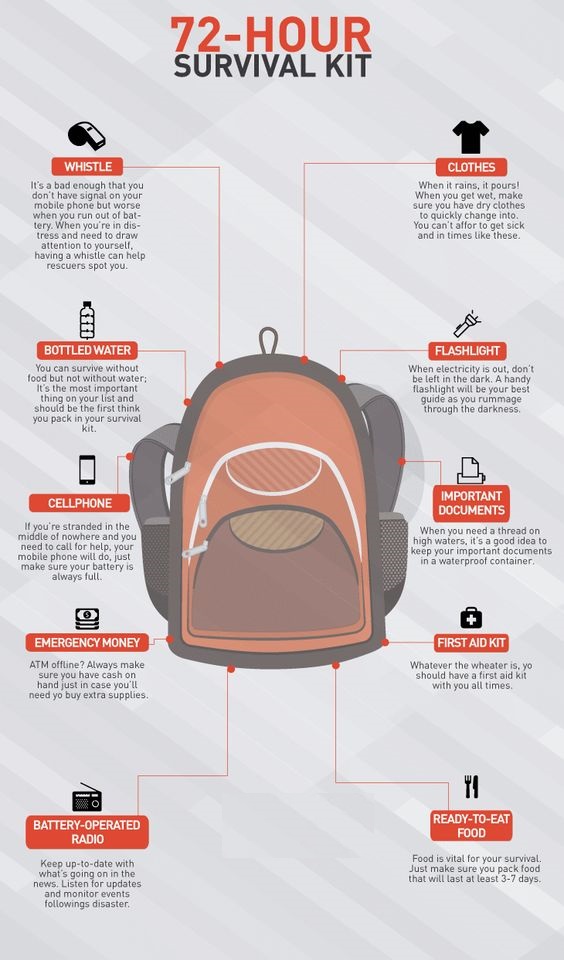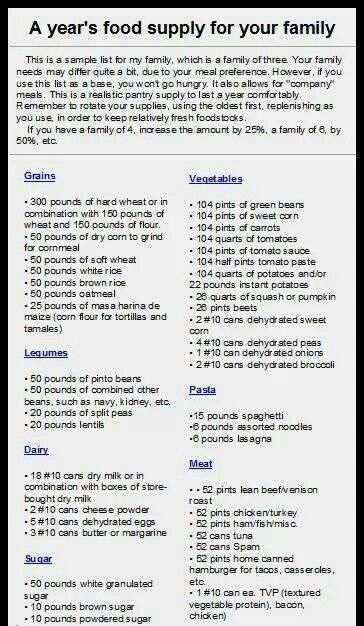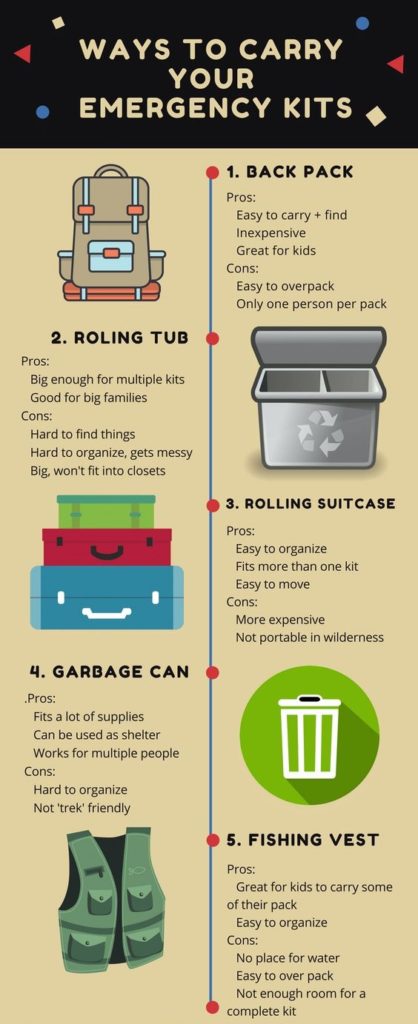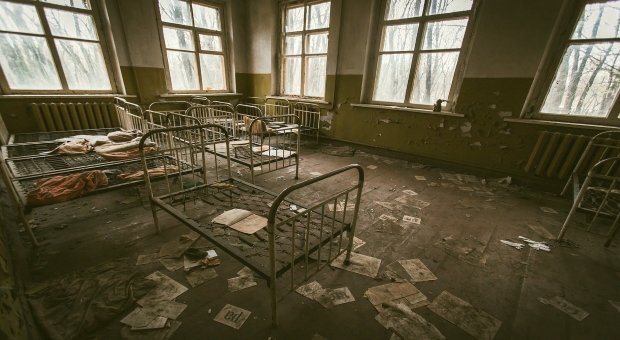It is estimated that around 40% of Americans have the means to survive for 3 days in case a SHTF scenario unfolds.
To be more precise, less than half of the people in our country have the resources (such as food, water, and fuel) to survive for 3 days. For the rest of the people, it’s a game of chance, and they will rely on the government to care for them. When desperation settles in, they will take matters into their own hands, and they will do whatever it takes to live another day.
The problem with emergency preparedness is that no one can really know how long a disaster will last. It may be just a few hours or it may take several months for things to get back to normal. Those who did not plan ahead for a long-term disaster will get a harsh wake-up call beyond the first 72 hours. The current trend is to equip a bug-out bag and rely as much on it as possible when it hits the fan. However, for the serious pepper, it’s important to understand that thinking beyond their bug-out bag is mandatory for long-term survival.
For example, let’s assume a failure of the regional or even worse, the nation’s electrical grid. In such a case, which is actually the #1 threat that can break down the entire structure of our country, people will have to fend for themselves. Just take one hour of your time and do a little research on this topic and you will realize how outdated and vulnerable our electrical grid is. You will understand that such a scenario is just a matter of when it’s going to happen.
As a general rule of mine, the main emergency preparedness advice I give to close friends, relatives, and my readers, is to divide their emergency preparedness planning into three stages. The time frames I recommend are 72 hours, two weeks, and long-term. All three-time frames are affected by the location of the preppers, the gear, and the skills they have. Since emergency preparedness can cover a lot of scenarios, I for one recommend doing a thorough analysis and establish which SHTF scenario is the most probable for each individual. I wrote a while ago about how this can be achieved without too much headache, and I will do it again, just to remind people about it.
When you will do an assessment for your case, you will most probably notice that the top 3 SHTF scenarios are natural disasters. Depending on where you live, occasionally, you will have a man-made disaster in the top 3. While some fear that a force may invade the U.S., this scenario is unlikely to happen. Our enemies are using nowadays various war tactics that are not visible to the general public as a force brute attack. Cyber attacks, spreading misinformation (fake news), and interfering in domestic processes (elections, economic transactions, etc.) are the new weapons they use.
With these variables in mind, it’s better to understand how the three-time frames should be handled and what the skills and supplies needed are.
72 hours, the most common time-frame for all
Within this period of time, survival is mostly connected to weather-related events or natural disasters. Most people prep for this time frame willingly or unwillingly and it’s considered a survivable period with even the most basic supplies. For some will become an inconvenience to survive without public utilities while for others, it will become a waiting game. Most people will just wait to see what happens, hoping that things will get back to normal. They will do so while stretching whatever resources they have and oftentimes, most of them will require exterior help (friends, neighbors, government structures, etc.). Some natural disasters like flooding or blizzards will make these the longest 72 hours of your entire life. Even so, survival is possible, and you will make it till things get back to normal. As a safety net, it is recommended that during this time frame you should have the following:
Water
Water is critical during this time frame and it should be a priority if you have a shelter in place. You should never use tap water after an SHTF event unless the authorities have declared it’s safe to do so. I recommend storing the water prior to the event if warnings have been issued. There are a lot of storage solutions to help you gather a good amount of water in a short amount of time. Water bricks and the waterBOB are my favorite choices. You will need to have more than a gallon of water for each day, and you have to multiply this quantity by the number of people available in your home (pets included).
In some cases, it’s recommended to store bottled water or use containers that can be easily moved. Certain natural disasters may force you to move temporarily, and you need to bring supplies along.
Food
Here, the situation is not as critical compared to your water needs. You can store all sorts of non-perishable foods, and there are a lot of companies offering various nutritious and tasty meals. Your local grocery store is a solid source for your stockpiling plan, and there are also online options of companies that specialized in the manufacture and selling of survival foods.
Emergency kit
The emergency kit can be comprised of items you have in your home or the items you placed in your bug out bag. These are the kind of items that will help you solve minor problems. For the most basic kits, some tape and rope, a flashlight, a hand-crank radio, a first aid kit, a fire starter, and a knife or a pocket multi-tool will be enough. These items will help you accomplish pretty much any tasks you can think of.

Cash
During natural disasters, the power grid may be temporarily down and all the ATMs and card readers from your region may not function. Having a reserve of cash will come in handy if there are businesses still operating or if you find people willing to sell you the things you need. The trick here is to have various denominations, to avoid keeping all the cash on you and never let anyone know how much you have available.
Weapons
No matter what your opinions or guns are, you will have to consider them as necessary tools to protect what’s yours and to defend your family. An SHTF event will often time bring out the worst in people, and you should have at least the minimum for personal protection. A handgun will be ideal for this situation.
Skills
The skills needed within this time frame are the basic first aid and self-care skills that you would use during a camping trip. The kind of skills that are ideal to have, and be able to use any day of the week regardless if you are facing an SHTF scenario or not. Besides this, you should have a basic understanding of how your house works and how to shut the water, gas, and electricity off if needed.
Two-weeks survival
This is the time frame for which the vast majority of people are prepping for, the concerned people, or the determined preppers. In fact, in recent years, nature has shown us that this time frame is much more realistic than some of us believed. You should assume that government support will be unavailable for a long period of time and that it’s impossible for the government agencies (no matter how willing they are) to care for everyone. It’s basic common sense at this point, and there’s just not enough to go around, and the probability of you being amongst the lucky ones that are covered by ongoing relief is slim to none.
Since every one of us is different, the prepping plans will differ from family to family. These plans will be affected by factors such as budget, location and accessibility, population density, and willingness to pursue your preparedness plan. This time frame can expand from two weeks to a few months. Make sure the following necessities are covered.
Water
During this time frame, water will become a complicated factor, and you will need various skills to make sure your family gets all the water it needs. If you have a large supply of water stored in a water tank or your house filled with bottled water, you won’t have to worry about this. However, if that’s not the case, you will need to concentrate your effort to purify drinking water, not only to quench your thirst but also to use it for cooking and sanitation necessities. Not to mention that you will need to identify a water source to supply your needs or in a worst-case scenario, employ a method to collect water.
Food
In two weeks, your food reserve may begin to run thin. You will need to store a good amount of canned foods and meals. Most importantly, you will need diversity and a proper food rotation system to prevent food fatigue. In some cases, those with money to spare will go for emergency meals and MREs because these are very calorie-dense and besides lasting quite a while, they can satisfy even the most pikey eaters.
Emergency kit
Besides keeping your initial emergency kit, you will need to update it with various tools for repair, maintenance, and clean-up jobs. I won’t go into details here as you can find info about this topic in a previous article I wrote about building a post-disaster tool kit.
Cash
Just like in the 72 hours time frame, the currency will still be recognized, and it will help you get what you need. However, the main problem here is the price gouging schemes many will implement. There will be a high demand for basic items, and they will charge you outrageous prices for them if you didn’t plan ahead. As you can assume, you will need to have more cash on hand for two weeks or more if there are items you need to get.
Skills
Your knowledge level will have to move up a notch and you will need to have advanced skills to deal with the unexpected factor. There may be a need to care for serious injuries if no professional medical help is available. You will need to know how to build various fire times for different necessities, how to build a shelter from various materials, how to do home repairs, and assure warmth for your family.
Weapons
Besides a handgun, it’s better if you include a small-caliber rifle in your prepping plans. I recommend going with a Ruger 10/22 since it can be used for defensive purposes and it can also be used to take down small game. Ideally, at least two members of your family should own a gun and they should be trained to use a said gun in case social upheaval may pose a problem.
Long-term survival
As preppers, we should always assume things will get really bad and we should properly prepare for it. Having high hopes and a kind spirit may not work in your favor when SHTF. You don’t think a long-term survival scenario is possible? Think about Puerto Rico, and look it up. A year, after Hurricane Maria ravaged the region, the rebuilding process is still not complete, and things are going at a slow pace. In a long-term survival scenario, you should not count on the government to come to your aid. There are things you need to figure out for yourself and plan for the long-term.
A long-term preparedness plan can be described as the road to achieve self-sufficiency. While for some, it may be achievable, for the majority of people, this becomes a lifetime journey. Even so, the main enemy both categories have to overcome is the human element. People will adopt a nomadic lifestyle and will compete for the available resources. Total isolation will be possible only for a small percentage of people, and human interaction and avoidance will become a day-to-day struggle. Let’s see how we could cover the main basic needs.

Water
Besides having the means to purify water (non-commercial means), you will need to invest a lot of time into collecting water or generating water from thin air. You will need to identify natural water sources; you will have to dig a well in a location that is not accessible to others and eventually, you will have to store a large quantity of water for longer periods of time regardless of the season.
Food
At this point, you will have to procure your food just like your ancestors did. Hunting and fishing are the main options, but these are not viable long-term solutions since there will be incredible competition for those resources. Foraging is another option, but it cannot sustain you long-term since the winter season is unforgiving, and most importantly, not everyone has the knowledge to forage successfully. You will need to grow your own food, and you can do so by having a concealed garden or by employing various guerilla gardening tactics. To supplement your meals, you will also have to grow small livestock and learn how to trap and snare.
Emergency kit
Your previous kits are good, but you will eventually need to add a variety of general, non-electrical tools. Besides the tools you will be using daily, you may need replacement parts for them and items to assure proper maintenance. When it comes to medical needs, at this point, you should have an EMT training and all the tools/items an EMT pack contains. Self-care will become a major concern for many, and some of them will rely on medicinal herbs to treat various illnesses. Once again collecting and using medicinal herbs requires a lot of practice and on the field experience.

Cash
Cash will become useless and only a reminiscence of the world we used to have. In time, a bartering system will be implemented between communities, but until rules and a local government of such establishments will be put in place, bartering will not be a safe task. Once you manage to join a bartering community, having high-value items will put you in an advantage.
After some time, things like ammunition, medicine, and various sanitary items will be in high demand. One important thing to specify here is that you will need to learn various tactics of bartering and you will need to outsmart most of the barters. For example, instead of trading batteries, offer to charge used batteries using a solar charger in exchange for other goods. Even better, trade depleted batteries for lesser items, charge them and trade them for the items you need.
Skills
The skills you will need are beyond those of an experienced camper. It will take a lifetime of trial and error to achieve self-sufficiency. Since there won’t be a chance to learn by example, you will need to build your own SHTF library and stock it with books on gardening, gunsmithing, woodworking, and pretty much all the skills our great grandfather had.
Weapons
In addition to your pistol of choice and the Rugger 10/22 rifle, you should include a Remington 870 shotgun and an AR-15 rifle. These additional firearms will keep you focused on both defensive and hunting purposes. The problem with building a proper arsenal is the need to pack a significant amount of ammunition. The number one question you will have to figure an answer for is how much ammo is enough?
Conclusion
The post SHTF effects can last from 72 hours to a few months. It is impossible to establish how much a crisis can last since there are always unknown factors coming into play. However, there are things you can do to plan for both short and long-term survival. It all depends on your willingness to pursue such preparedness plans.
Some will think it’s enough to have a bog out bag while others will do whatever they can to prepare for a few months or a year. The most fortunate and resilient of preppers will find a way to achieve self-sufficiency and survive long-term. No matter what type of person you are, always hope for the best and prepare for the worst!





















































































Bob, your “Layered” Approach is the right way to categorize All of the decisions each of us must make. You have added some Very Helpful Ideas for All of us to use. Thank You.
Been there. Read that. At least a 100 times. Lets get advanced and talk about something we haven’t talked about.
What could that possibly be? Its all been covered ad nauseam. I’m 45 years preparing. Heard it all, seen it all. The world was going to end 45 times. Probably more. Yes, things are different now. But things are always “different now”. Prepare for “lights out”, and you will be covered. So, if you have a suggestion regarding what’s discussed, pipe up. If not, keep your criticism.
No-one ever talks about garbage and human waste. If you live with a septic system, fine. If you are on a government sewage system you had better plan for some alternative.
So true. A few yrs ago we had a national trucker strike that all but paralyzed everything. No fuel, emptying grocerie shelves, and … fewer police and sanitation. In big and even medium cities things can and do get ugly quite fast I can tell you. And it doesn’t take a meteor or a big accident. In fact, it’s the more likely breakdowns such as (you guessed) a pandemic, economic collapse or social unrest. Usually the 3 combined LOL
I know this is a scary prospect. And, MAC is somewhat correct. I’ve spotted several porta potties close to home. Since I’m capable of handling the food and water situation. My plan has been to grab two of the potties. It’s a much better situation for us. We can disinfect it. we can transport the waste to oil company supplied reservoirs that contain oil contamination.
I submit, sticking to the limited information give in these webpages is way to limiting. While I don’t accept Forward Observer at face value, he does stimulate some thinking, again, only in a narrow range. One of the aspects of these situations, is the mentally nimble are really the survivors. People who just do as education herein, are not likely to last long.
Using your mind. Exercising your thinking meat, is what you need. Thinking ahead. I’d like to see one of these sites build some survival puzzles (not tests or predetermined scenario’s) to test our adaptability and creativity. A group think plan build project for specific situations. Pick a random, or fake, location and situation. Then several people develop their proposed plans. Another group of people to be the opposing environment/people.
I’d actually challenged Canadian Prepper to take the top of the line preppers and survivalists into the wilds of Canada and let the last one to give up be the winner. Naturally he ignored me. That was too scary of a prospect for him.
A few yrs ago I started going out on the streets (big, big city in a 3rd world country here) to try and test myself, my skills and my gear to see how much I could adapt to the harsh urban environment.
I’m already a camper backpacker trekker bushcrafter but since I’d have to deal with the city in any SHTF scenario, even before having to bug out or something,
I decided to see how it is for real. I can tell you, if anyone have the means and skills and resilience to go further as longer in a breakdown of society, it’s the homeless. Sad but true. So since then I’ve been going out of comfort zone with almost nothing but the basic to try and survive for a few days in the urban environments.
Now see, MKS. Let’s talk poo. Rarely covered. I’m in the woods, so the outhouse is king, (queen), don’t mess up the “house”. We have septic, but also a fancy “outdoor guest bathroom”. Even in town, waste should be returned to the earth. I don’t mean just tossed on the ground, out a window. Wind row composting w/sawdust, straw, soil, etc., for later use. Or simply buried. Have lime on hand for both. Storing in plastic bags for later disposal is not a good idea. Breeding ground for disease. VERY difficult to handle, and you still have contaminated plastic bags. Poo talk.
I like the way you break up the planning! I know for small emergencies, I also keep a list of phone numbers. For disasters very small term my list includes insurance, disaster restoration services, and emergency contact numbers.
These are all good ideas, but you never mention you may have to kill someone to protect your family, Why is this?